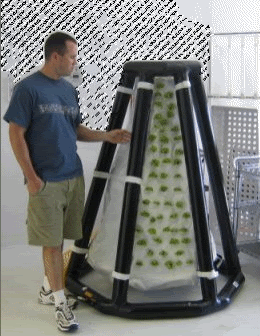In 1999, Stoner, funded by NASA, developed an inflatable low-mass aeroponic system for space and earth for high performance food production. In 1999, Stoner, funded by NASA, developed an inflatable low-mass aeroponic system (AIS) for space and earth for high performance food production.
NASA low-mass Inflatable Aeroponics System (AIS) - achieved 1999
Abstract: Aeroponics International’s (AI’s) innovation is a self-contained, self-supporting, inflatable aeroponic crop production unit with integral environmental systems for the control and delivery of a nutrient/mist to the roots. This inflatable aeroponic system addresses the needs of subtopic 08.03 Spacecraft Life Support Infrastructure and, in particular, water and nutrient delivery systems technologies for food production. The inflatable nature of our innovation makes it lightweight, allowing it to be deflated so it takes up less volume during transportation and storage. It improves on AI’s current aeroponic system design that uses rigid structures, which use more expensive materials, manufacture processes, and transportation. As a stationary aeroponic system, these existing high-mass units perform very well, but transporting and storing them can be problematic.
On Earth, these problems may hinder the economic feasibility of aeroponics for commercial growers. However, such problems become insurmountable obstacles for using these systems on long-duration space missions because of the high cost of payload volume and mass during launch and transit.
The NASA efforts lead to developments of numerous advanced materials for aeroponics for earth and space.
NASA Inflatable Aeroponics
8:23 PM
ThanateTan







